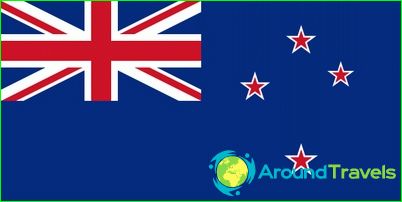Flag of new zealand

The current flag of New Zealand was adopted on March 24, 1902, it is a rectangular cloth of predominantly blue color with a side proportion of one to two. It features the UK flag in the upper left corner. «Union Jack» (otherwise called «union jack»), which symbolizes the historical belonging of New Zealand to the British Empire. The country is a former colony and now a member of the British Commonwealth. On the right half of the flag, four classic stars are depicted, which are a symbol of the geographic location of the state. They also represent the four brightest stars in the constellation Southern Cross. They are red in color and have a thin white border..
From 1834 to 1840 the flag of the United Tribes of New Zealand was used, which was also based on the flag of England. It had a white background, a red St. George's cross in the middle and an invading country flag in the upper left corner, which also consisted of the St. George's cross and four red stars on a blue background. Then, until 1902, from time to time, the flag of New Zealand was completely replaced by the Union Jack, since Great Britain remained the full ruler of this land..
In 1867, the first flag was adopted, based on the English blue flag, based on «Colonial Fleet Protection Act». According to this innovation, all ships in the colony carried a blue flag belonging to the Royal Navy, emblazoned with the emblem of the colony. But since New Zealand did not have its own emblems or coats of arms, the letters NZ, red with a white border, were simply installed on its flag (which meant New Zealand).
And already in 1869 the current version of the flag was adopted, which at first could only be used on government ships. But due to the patriotism shown during the second Boer War, the adopted flag in 1902 gradually became national. This caused disorder in connection with the use of different versions of the flag, and therefore the liberals in power introduced the Banner and Code Signals Bill, which was approved by King Edward VII on March 24, 1902..
As for the symbolism of the colors of this flag, their meaning does not differ from the British version, which is the basis. Blue symbolizes the sea (which for New Zealand may be a symbol of the ocean), red is nothing more than the cross of St. George, meaning England, and the white oblique cross of St. Andrew is the designation of Scotland. The oblique red cross of St. Patrick is a symbol of Northern Ireland.


